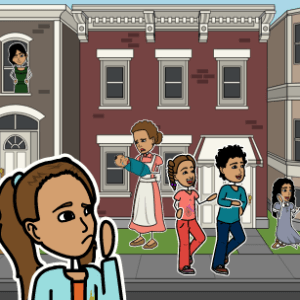Activity Overview
Figurative language is used frequently in The House of Mango Street, most notably in the chapter, "Hair". Four common forms of figurative language are metaphor, simile, personification, and hyperbole.
Type |
Definition | Example |
|---|---|---|
| Metaphor | an implied comparison between two things | Her smile was a ray of sunshine on a dreary day. |
| Simile | a comparison using the words "like" or "as" | The thorn cut like a razor. |
| Personification | giving human-like characteristics to non-human objects | The wind whispered its secrets through the trees. |
| Hyperbole | use of exaggeration to prove a point | This traffic light is taking forever! |
Find three or more examples of figurative language and, using a T-Chart, create two columns: one quoting the book with matching illustration, and the second showing the figurative language with an illustration of what it would literally look like. For example: along with “Papa’s hair is like a broom”, the cell might show Papa with actual brooms on his head.
Template and Class Instructions
(These instructions are completely customizable. After clicking "Copy Activity", update the instructions on the Edit Tab of the assignment.)
Student Instructions
Create a storyboard that shows examples of figurative language in The House of Mango Street.
- Click "Start Assignment".
- Identify use of figurative language in the text.
- Put the type of figurative language (such as simile or metaphor) in the title box.
- Give an example from the text in the description box.
- Illustrate the example using using a combination of scenes, characters, and items.
Lesson Plan Reference
Rubric
(You can also create your own on Quick Rubric.)
| Proficient | Emerging | Beginning | |
|---|---|---|---|
| Examples of Figurative Language | There are three examples of figurative language in the description boxes. | There are two correct examples of figurative language in the description boxes. | Only one of the examples of figurative language is correct. |
| Types of Figurative Language | All three examples are correctly identified as simile, metaphor, hyperbole, or personification (or other). | Two examples of figurative language are correctly identified as simile, metaphor, hyperbole, or personification (or other). | Only one example of figurative language is correctly identified as simile, metaphor, hyperbole, or personification (or other). |
| Illustrations of Literal and Intended Meanings | Illustrations show both the literal meaning of the text and the intended meaning of the figurative language. | Illustrations show either literal meaning or intended meaning, but not both. | Illustrations do not make sense with the examples chosen. |
Activity Overview
Figurative language is used frequently in The House of Mango Street, most notably in the chapter, "Hair". Four common forms of figurative language are metaphor, simile, personification, and hyperbole.
Type |
Definition | Example |
|---|---|---|
| Metaphor | an implied comparison between two things | Her smile was a ray of sunshine on a dreary day. |
| Simile | a comparison using the words "like" or "as" | The thorn cut like a razor. |
| Personification | giving human-like characteristics to non-human objects | The wind whispered its secrets through the trees. |
| Hyperbole | use of exaggeration to prove a point | This traffic light is taking forever! |
Find three or more examples of figurative language and, using a T-Chart, create two columns: one quoting the book with matching illustration, and the second showing the figurative language with an illustration of what it would literally look like. For example: along with “Papa’s hair is like a broom”, the cell might show Papa with actual brooms on his head.
Template and Class Instructions
(These instructions are completely customizable. After clicking "Copy Activity", update the instructions on the Edit Tab of the assignment.)
Student Instructions
Create a storyboard that shows examples of figurative language in The House of Mango Street.
- Click "Start Assignment".
- Identify use of figurative language in the text.
- Put the type of figurative language (such as simile or metaphor) in the title box.
- Give an example from the text in the description box.
- Illustrate the example using using a combination of scenes, characters, and items.
Lesson Plan Reference
Rubric
(You can also create your own on Quick Rubric.)
| Proficient | Emerging | Beginning | |
|---|---|---|---|
| Examples of Figurative Language | There are three examples of figurative language in the description boxes. | There are two correct examples of figurative language in the description boxes. | Only one of the examples of figurative language is correct. |
| Types of Figurative Language | All three examples are correctly identified as simile, metaphor, hyperbole, or personification (or other). | Two examples of figurative language are correctly identified as simile, metaphor, hyperbole, or personification (or other). | Only one example of figurative language is correctly identified as simile, metaphor, hyperbole, or personification (or other). |
| Illustrations of Literal and Intended Meanings | Illustrations show both the literal meaning of the text and the intended meaning of the figurative language. | Illustrations show either literal meaning or intended meaning, but not both. | Illustrations do not make sense with the examples chosen. |
More Storyboard That Activities
House on Mango Street, The
This Activity is Part of Many Teacher Guides
Pricing for Schools & Districts
© 2024 - Clever Prototypes, LLC - All rights reserved.
StoryboardThat is a trademark of Clever Prototypes, LLC, and Registered in U.S. Patent and Trademark Office










